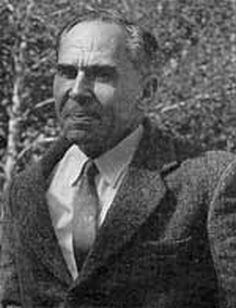Name Herbert Andrewartha | ||
 | ||
Died January 27, 1992, Adelaide, Australia Books The Distribution and Abun, The Ecological Web: Mor, Introduction to the Study of, Selections from The Distributi | ||
Professor Herbert George Andrewartha, BS (UWA), MAgSc (Melb), DSc (Adel), FAA, (21 December 1907 – 27 January 1992) was a distinguished Australian research scientist in the fields of entomology, biology, zoology and animal ecology.
Contents
In the twentieth century, Andrewartha became the most influential Australian ecologist, and best known for attributing density-independent forces, such as weather, to be even more important than density-dependent factors in influencing population regulation. In 1933, Andrewartha began his studies on apple thrips, Thrips imagines, but later transitioned his studies to the plague grasshopper, Austroicetes, when he moved to Adelaide in 1935. This led to his first publication with his former student Charles Birch in 1941, “The influence of weather on grasshopper plagues in South Australia”. In 1945, when his mentor James Davidson died, Andrewartha inherited fifteen years of data collected on thrips population. After several years of statistical analysis of these data, Andrewartha and Birch demonstrated strong connections between physiology, population levels, and other environment factors and this led to the publication of two major books, The Distribution and Abundance of Animals (1954) and The Ecological Web (1984). Through this work, Andrewartha and Birch found a new school of population ecology, which emphasized the role of environmental controls as opposed to community-dependent approach based on density-dependent factors. The joint work of Andrewartha and Birch helped them earned the Eminent Ecologist Award, which had never been presented jointly to two persons previously from the Ecological Society of America.
[1] http://people.wku.edu/charles.smith/chronob/ANDR1907.htm
[2] http://www.esa.org/history/Awards/bulletin/eminent1988.pdf
Early years
Andrewartha was born on December 21, 1907 in Perth, Western Australia to George and Elsie, the second of three children. His father was a teacher, and the family moved frequently from school to school in rural Western Australia.
Andrewartha holds his Bachelor of Agriculture from the University of Western Australia. He later received his doctorate from the University of Adelaide in 1972.
[1] http://www.eoas.info/biogs/P000018b.htm
Career
Retirement and death
Andrewartha retired in 1972. In 1975 he suffered a serious stroke, but continued writing his last book with Birch. He died on 27 January 1992 at the age of 84. He married Hattie Vevers Steele in Melbourne in 1934. His wife predeceased him: he was survived by his son Graeme and daughter Susan Dutch.
